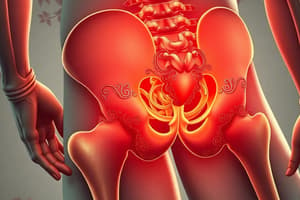Podcast
Questions and Answers
What can weakness of the abductor muscles due to lateral pelvic tilt contribute to?
What can weakness of the abductor muscles due to lateral pelvic tilt contribute to?
- Increased compressive forces on the ITB and bursa (correct)
- Decreased compressive forces on the ITB and bursa
- Reduced irritation of the gluteal tendons
- Enhanced muscle flexibility
How is GTPS primarily diagnosed?
How is GTPS primarily diagnosed?
- By laboratory tests
- Using physical examination and patient history (correct)
- Based on imaging studies alone
- Through genetic testing
What is the primary symptom of Greater Trochanteric Pain Syndrome (GTPS)?
What is the primary symptom of Greater Trochanteric Pain Syndrome (GTPS)?
- Pain in the lower back
- Pain on the side of the hip (correct)
- Knee pain
- Shoulder pain
What is a common symptom of GTPS that may be revealed by palpation of the greater trochanter region?
What is a common symptom of GTPS that may be revealed by palpation of the greater trochanter region?
Which activities can trigger or worsen the pain in patients with GTPS?
Which activities can trigger or worsen the pain in patients with GTPS?
What is a possible cause of Greater Trochanteric Pain Syndrome according to studies?
What is a possible cause of Greater Trochanteric Pain Syndrome according to studies?
What is the initial treatment approach for GTPS?
What is the initial treatment approach for GTPS?
What role does the iliotibial band play in Greater Trochanteric Pain Syndrome?
What role does the iliotibial band play in Greater Trochanteric Pain Syndrome?
In refractory cases of GTPS, what additional intervention may be considered?
In refractory cases of GTPS, what additional intervention may be considered?
How is tendinopathy related to Greater Trochanteric Pain Syndrome?
How is tendinopathy related to Greater Trochanteric Pain Syndrome?
What is the prognosis for individuals with GTPS?
What is the prognosis for individuals with GTPS?
When might a patient with Greater Trochanteric Pain Syndrome experience tenderness around the greater trochanter?
When might a patient with Greater Trochanteric Pain Syndrome experience tenderness around the greater trochanter?
Study Notes
Understanding Greater Trochanteric Pain Syndrome: Symptoms, Causes, and Treatments
Greater trochanteric pain syndrome (GTPS) is a common condition characterized by persistent lateral hip pain. The exact cause remains debated but is thought to involve inflammation, poor healing of tissue injuries, or compression of the gluteal tendons in the peritrochanteric space.
Symptoms
The primary symptom of GTPS is pain on the side of the hip, which is often felt during weight-bearing activities such as walking, climbing stairs, or lying on the affected side at night. The pain may progressively worsen over time and may be triggered or exacerbated by sudden unaccustomed exercise, falls, prolonged standing, or sporting activities, particularly long-distance running. Additionally, patients may experience tenderness when the region around the greater trochanter is palpated.
Causes
The causes of GTPS are not well understood, but several theories have been proposed. One theory suggests that inflammation of the bursa between the gluteal muscles and the greater trochanter is responsible for the condition. However, studies using imaging techniques have shown that bursitis is rare in this location. Instead, tendinopathies involving the gluteus medius and/or minimus muscles seem to be the main culprit. The iliotibial band compressive forces onto the greater trochanter contribute to the issue.
Another contributing factor is weakness of the abductor muscles due to lateral pelvic tilt, which increases compressive forces on the ITB and the bursa. This can lead to irritation and inflammation of the gluteal tendons, ultimately causing pain.
Diagnosis
GTPS is primarily diagnosed based on clinical findings, including patient history, physical examination, and imaging studies if necessary. Palpation of the posterolateral region of the greater trochanter may reveal focal tenderness, while specific tests like resisted abduction or internal rotation against resistance can help confirm the diagnosis. These tests are more sensitive than palpation alone but less specific, so they should be used alongside other assessment methods.
Treatment
Initial treatment for GTPS involves conservative measures such as rest, ice, compression, elevation, nonsteroidal anti-inflammatory drugs (NSAIDs), and physical therapy. The goal is to improve local muscle strength and flexibility to reduce symptoms. For refractory cases, local extracorporeal shock wave therapy may be considered. If symptoms persist despite these treatments, additional interventions like corticosteroid injections or platelet-rich plasma (PRP) injections may be attempted. As a last resort, surgery may be indicated for patients with chronic symptoms and severe muscle atrophy or fatty infiltration.
Long-term Outcomes
The prognosis for individuals with GTPS is generally good, with most patients experiencing improvement or resolution of symptoms with conservative treatment. However, there is a lack of long-term studies on the outcomes of people with GTPS, which highlights the need for more research in this area.
In conclusion, GTPS is a common condition that affects individuals, particularly those between the ages of 40 and 60, and is more prevalent in females. The primary symptoms are lateral hip pain and tenderness, which can be exacerbated by weight-bearing activities. Although the exact cause remains unclear, it is thought to involve tendinopathy of the gluteal muscles due to compressive forces and ITB irritation. Treatment primarily involves conservative measures, but for refractory cases, additional interventions may be required.
Studying That Suits You
Use AI to generate personalized quizzes and flashcards to suit your learning preferences.
Description
Test your knowledge on greater trochanteric pain syndrome (GTPS), a common condition characterized by lateral hip pain. Learn about the symptoms, causes, diagnosis, and treatment options for GTPS. Understand the long-term outcomes of this condition and the demographic it affects.




